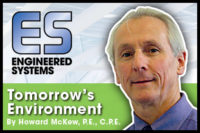This past winter in New England, I was contracted with resolving several problematic central air systems at various locations where each unit was shutting down from its freeze-stat device. In each case it was pretty obvious to me that there were two problems. The first problem was the design engineer was relying too much on the equipment manufacturer for unit configuration, and the second problem was, I believe, that all heating and A/C units are designed and built by equipment manufacturers living in the south.
Going The Distance
Starting with the problem of design engineer relying on equipment manufacturers, I’ve observed today’s popular practice of equipment sales engineers working with the design engineer where they provide “everything you need to design around their equipment.” It is not uncommon for the sales person to simply obtain the design parameters and then deliver the optimum equipment selection, configuration, performance criteria, specification, and even CAD layout of the equipment shown in plan view and various elevations (front, back, left side, and right side).When I ask engineers why they don’t engineer the system themselves and then pass it by a couple of equipment manufacturers to get feedback regarding the design, the response is usually, “We don’t have the fee to do this, and the sales engineer will do it for nothing!” Hmmm, do it for nothing?
Continuing on, I asked one designer why she was using a draw-through unit with one fan vs. a blow-through and with two fans. The response? “This is what the sales engineer provided.” Digging deeper, I came to realize this designer didn’t really consider the advantages and disadvantages of draw-through to blow-through or one-, two-, or three-fan application, not to mention the advantages and disadvantages of fan curve performance over the full range of her design. So, who will stand behind this design on a cold winter night?
In each of these winter freeze-stat problems, it appeared the design engineer overlooked the issue of cold air stratification when receiving the free unit selection, which leads to problem #2.
With each of the central AHU installations I observed this winter, the designer and the manufacturer overlooked the potential for outdoor air and return air not mixing together at minimum supply airflow, which occurs in the heating season.
On two projects, the outdoor air entered from the side of the unit taking a hard left turn directly to the entering side of the heating coil. The return air came back from the rear of the unit so that this air continued to move forward, covering the middle and right-hand side of the coil. With the use of a freeze-stat that was not an averaging-type sensor, these units would trip out, sending an alarm to the building management computer because of the cold air crossing the left-hand side of the coil. The solution was to add an outside air diverter to force the air into the return airstream. So much for getting something for nothing.
At a couple of other problematic installations, each central air unit’s mixed air plenum backed up to the outdoor air louver, and the manufactured product came with the intake located at the bottom of the plenum so the minimum air could hug the bottom of the unit and cross the heat coil unaffected by the return air that was coming into the top of the manufactured mixed air plenum. Like the units with outdoor air intakes entering from the side of the plenum as noted herein, this configuration allowed natural stratification to occur. So another free engineered solution resulted in baffles being added after the design and after a lot of back-and-forth between designer, HVAC contractor, automatic temperature control contractor, and the building owner’s staff.
Make It Your Own
Going back to the comment that the designer didn’t have an adequate fee to design the job that the engineering firm signed a contract to do, I find this inexcusable and contradicts why consultants are in the business of providing design services. If you are going to be providing these services, you better figure out how to deliver a quality product while making a profit. If you can only do one of the two, you won’t be in business long. If you are going to have a staff of design engineers perform consulting tasks, they should be educated to deliver a quality product while making a profit.Everyone makes mistakes, and building owners, as a rule, will accept changes. Why open yourself up to allowing equipment manufacturers to make mistakes for you? Use equipment manufacturers as a reference and not as your designer, or work with equipment manufacturers from Canada and Alaska.ES

